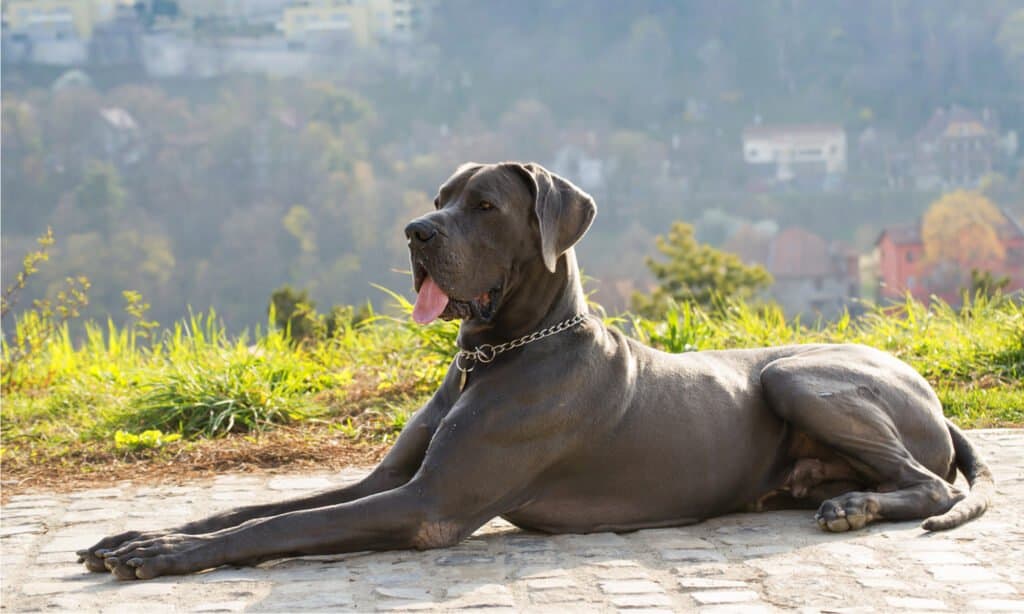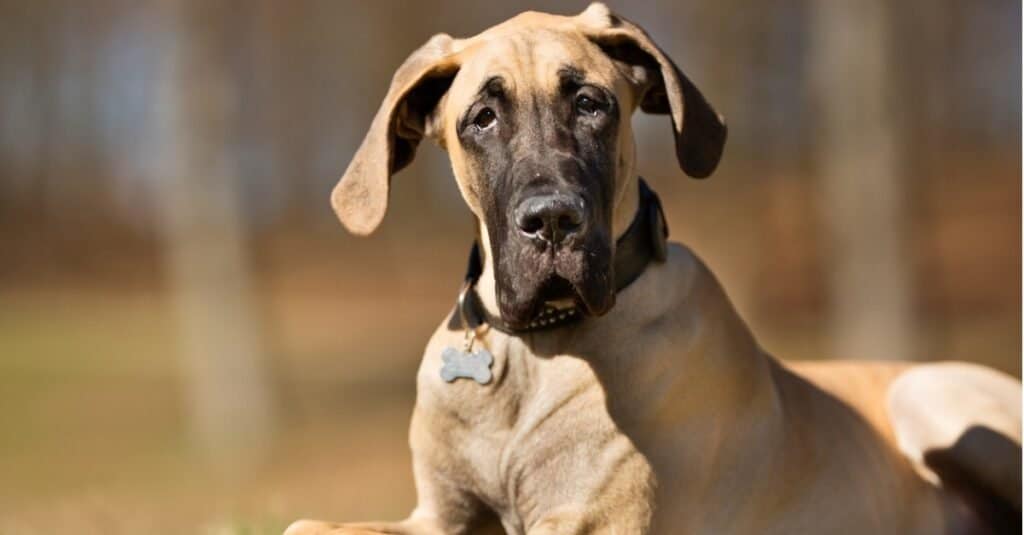Numerous huge dog enthusiasts are torn between the Great Dane and the “Mastiff” (the English Mastiff.) Both dog breeds share a few qualities in common. They are, nevertheless, distinct in a variety of ways. This post will compare eight significant characteristics of Mastiffs and Great Danes. We’ll look at topics including looks, personality, and health.
Great Dane vs Mastiff: A Comparison

| Great Dane | Mastiff | |
| Height | 28 – 32 inches | 28 – 31 inches |
| Weight | 110 to 175 lbs. | 120 to 230 lbs. |
| Coat type | Short, Fine, Dense | Short, Dense, Straight, Double coat |
| Colors | Fawn, Blue, Brindle, Merle, Black, Harlequin, Mantle | Apricot, Fawn, Brindle |
| Temperament | Gentle, Intelligent, Loving | Friendly, Brave, Cheerful |
| Trainability | Average | Average |
| Life Expectancy | 8 to 10 Years | 6 to 12 Years |
| Health Problems | Bloat, Cardiomyopathy, Hip Dysplasia | PRA, Hip Dysplasia, Seizures |
Key Differences between Great Dane and Mastiff

The English Mastiff differs from the Great Dane in appearance, size, and lifespan.
©iStock.com/marcelinopozo
The major differences between the Great Dane and the English Mastiff are their size, temperament, health condition, and appearance. Their position on the gigantic spectrum is another reason to mention. For example, the Great Dane is a very tall and long dog, but the English Mastiff is very broad. The Mastiff and the Great Dane are both massive, powerful dogs that rank among the largest dog breeds in the world. Although Mastiffs and Great Danes have a similar build, both breeds are immediately identifiable.
Let’s look at some essential differentiators.
Great Dane vs Mastiff: Height
A mastiff standing up is 28″ – 31″ tall, whereas Great Danes have a height of roughly 28″ – 32″, making them taller.
Great Dane vs Mastiff: Weight
An English Mastiff and a Great Dane are two of the largest dog breeds in physical size. Weights range from 160–230 pounds for a Mastiff male and 120–170 pounds for a Mastiff female, with some topping the scales at 300 pounds!
Between 110 and 175 pounds is the ideal weight for a fully grown Great Dane. If it exceeds certain limits, it is considered unhealthy.
Great Dane vs Mastiff: Coat Type
Great Danes have a single, short coat that is both smooth and lustrous. ‘Grooming and maintaining the coat is a simple process. However, the hair loss in Great Danes is seasonal, with a greater loss in spring and a lesser loss year-round.
Mastiffs have a short and dense double coat with two layers: a wiry “guard hair” and a wooly “undercoat.” To see the Mastiff’s undercoat, split the dog’s hair with your fingers; otherwise, it remains hidden.
Great Dane vs Mastiff: Color
Great Danes have their typical colors, the most common of which is a fawn coat. The American Kennel Club also recognizes harlequin, Mantle, Merle, Black, Blue, and Brindle as valid color variations.
The AKC and FCI only recognize three coat colors or patterns for the Mastiff: apricot, brindle, and fawn. The UKC recognizes both silver fawn and dark fawn-brindle in its breed standard. The UKC, on the other hand, sees no problem with any other color difference except for albinism.
Great Dane vs Mastiff: Temperament

Great Danes are a pretty laid-back breed that gets along well with children.
©belu gheorghe/Shutterstock.com
When raised with other animals, Great Danes generally get along with them, but certain members of the breed can be aggressive toward canines they don’t know. Compared to other dog breeds, Great Danes have a more laid-back personality. It has been shown that Great Danes are good at interacting with children. While Great Danes are large dogs, they need a lot of room to spread out and relax, so small children should be cautious. As a person who enjoys spending time with large, loving dogs, the Great Dane is a great choice.
Many families with children of all ages enjoy the company of English Mastiffs since they are friendly and non-aggressive. When it comes to English Mastiffs, they’re naturally interested and brave. These daring but well-behaved canines can thrive in a variety of circumstances. It’s not necessary to have a massive house for a dog like this, but it requires adequate space because of its large size.
Great Dane vs Mastiff: Trainability
Even though Great Danes are typically easy to train, some experts contend that it can be challenging. If they are not properly trained at an early age, they can become overly domineering. Great Danes are also quite sensitive, so they should be trained with excitement from the beginning. Harshness causes them to become confused and scared.
Mastiffs have a strong desire to please their owners and are pretty straightforward to train. However, although the Mastiff is not as sensitive as the Great Dane, it does not react well to forceful training methods.
Great Dane vs Mastiff: Health Problems
Great Danes are prone to bloating, cardiomyopathy, heart illness, hip dysplasia, wobbler syndrome (a dangerous neck vertebral condition), osteosarcoma, skin irritation, cataracts, and non-tumorous skin growths.
Mastiffs are prone to a common condition called hypothyroidism, in which the body doesn’t make enough thyroid hormone. They are also prone to cancer, bloat, seizures, and Progressive Retinal Atrophy (PRA), a deteriorating eye condition.
Great Dane vs Mastiff: Life Expectancy

Great Danes live an average of 8 to 10 years due to their massive size and inherent health risks.
©iStock.com/Bigandt_Photography
Great Danes don’t average any longer when it comes to lifespan, as they only live an average of 8 to 10 years. Some live as little as 6 or 7 years, and a select few have been known to reach 12.
The average lifespan of a Mastiff is between 6 and 12 years. This is a big difference, and a multitude of factors will dictate the age at which your Mastiff’s health begins to deteriorate. Unfortunately, larger dogs mature more quickly and have more health problems, resulting in a shorter lifespan even in ideal circumstances.
Wrapping up Great Dane and Mastiff
The sizes, colors, temperaments, and health of these canines are similar, yet all distinct from one another. However, even though both species make excellent family dogs and are well-liked by many, some choose other breeds because of their enormous size. Generally, adopting one of these pups implies that you are committed to a dog almost the same size as an adult human being! On the other hand, you will have a buddy who will be faithful and affectionate for their entire life.
The photo featured at the top of this post is © iStock.com/Earl-Wilkerson
Ready to discover the top 10 cutest dog breeds in the entire world?
How about the fastest dogs, the largest dogs and those that are -- quite frankly -- just the kindest dogs on the planet? Each day, AZ Animals sends out lists just like this to our thousands of email subscribers. And the best part? It's FREE. Join today by entering your email below.
Thank you for reading! Have some feedback for us? Contact the AZ Animals editorial team.






